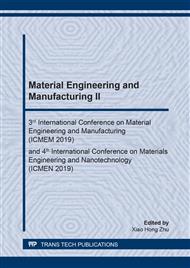p.116
p.121
p.133
p.139
p.145
p.151
p.156
p.165
p.173
Effects of Gases Temperature on the Viscosity and Flow Velocity of Melt in the Gas-Assisted Extrusion Forming of Plastic Micro-Tube
Abstract:
To ascertain the influence of gases temperature on the viscosity and flow velocity of melt in the gas-assisted extrusion forming of plastic micro-tube, the three phase fluid geometric model was established and the finite element numerical simulation method was used in this paper. In the simulations, four different assisted-gases temperatures were imposed on the inlet boundaries of inner and outer assisted gas layers. Under a certain inlet volume flow rate of melt and assisted gases, as well as the thermal boundaries conditions, the numerical results about the effect of gases temperature on the viscosity and flow velocity of melt for the gas-assisted extrusion forming of the plastic micro-tube were obtained. Results show that with the increase of gases temperature, the viscosity distribution of melt in the radial direction of die channel decreases. However, at the axial direction of die channel, when the gases temperature is less than that of the melt, the viscosity of melt increases first and then decreases finally increases outside of die. When the gases temperature is larger than that of melt, the viscosity of melt decreases first and then increases finally increases outside of die. In addition, the flow velocity of melt increases with the gases temperature.
Info:
Periodical:
Pages:
145-150
Citation:
Online since:
January 2020
Authors:
Price:
Сopyright:
© 2020 Trans Tech Publications Ltd. All Rights Reserved
Share:
Citation:


